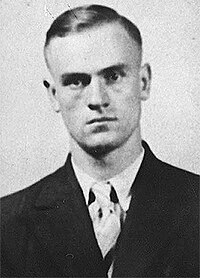Igor Gouzenko | |
|---|---|
| Игорь Сергеевич Гузенко | |
 Gouzenko in 1946 | |
| Born | Igor Sergeyevich Gouzenko January 26, 1919 |
| Died | June 25, 1982 (aged 63) Mississauga, Ontario, Canada |
| Nationality | Russian, Canadian |
| Other names | George Brown |
| Occupation | Cipher clerk |
| Known for | Exposing Soviet spy ring in Canada |
| Signature | |
 | |
Igor Sergeyevich Gouzenko (Ukrainian: Ігор Сергійович Гузенко; January 26, 1919 – June 25, 1982)[1] was a cipher clerk for the Soviet embassy to Canada in Ottawa, Ontario, and a lieutenant of the Soviet Main Intelligence Directorate (GRU).[2][3] He defected on September 5, 1945, three days after the end of World War II, with 109 documents on the USSR's espionage activities in the West. In response, Canada's Prime Minister, Mackenzie King, called a royal commission to investigate espionage in Canada.
Gouzenko exposed Soviet intelligence's efforts to steal nuclear secrets as well as the technique of planting sleeper agents. The "Gouzenko Affair" is often credited as a triggering event of the Cold War,[4] with historian Jack Granatstein stating it was "the beginning of the Cold War for public opinion" and journalist Robert Fulford writing he was "absolutely certain the Cold War began in Ottawa".[5] Granville Hicks described Gouzenko's actions as having "awakened the people of North America to the magnitude and the danger of Soviet espionage".[6]
- ^ Family member verification; January 13, 1919 was old calendar.
- ^ Lev Laĭner (2003). "Венона". Самая секретная операция американских спецслужб. ОЛМА Медиа Групп. ISBN 978-5-94849-363-3.
- ^ "The Cold War began with Igor Gouzenko; his kids went to a Mississauga high school undercover". insauga | Local Online News. January 28, 2021. Retrieved January 11, 2022.
- ^ "CBC Archives".
- ^ "Soviet Defector Believed Beginner of Cold War". Toledo Blade. December 25, 1984. Retrieved July 23, 2012.
- ^ Hicks, Granville (July 18, 1954). "Decline and fall of a Russian idol". The New York Times. Retrieved June 1, 2019.